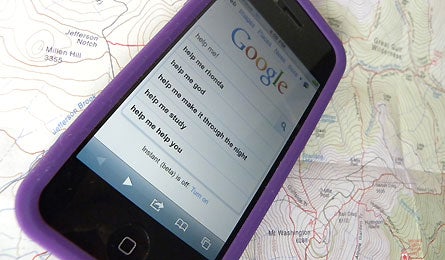Prof. Hike: Rely on Yourself, Not on Your Phone

'professor hike iphone 445x260'
If I was a savvy investor I’d buy stock in companies that make stretchers, gauze, and splints. That’s because search and rescue season is heating up. Every spring, as more hikers and campers head outdoors, the number of calls to wilderness SAR teams surges. Should you follow the Wall Street adage to ‘sell in May and go away?’ Not when the market for human calamity is so bullish.
Take Drew Lancaster. On Sunday, May 8th the 24-year-old student went for a day-hike near Berthoud Pass, Colorado. Wearing tennis shoes and unprepared for the steep, snow-covered terrain, Lancaster got lost, tired, and thirsty before twisting his ankle. Although he spotted highway U.S. 40 hugging the mountainside 500 above him, he couldn’t reach it. So he dialed 911 on his smartphone. Despite poor cellular reception, Lancaster contacted police via text message, took bearings of a nearby peak using his phone’s compass app, and sent texts to direct rescuers to his location where he was evacuated by stretcher.
That fact that Lancaster got rescued is a good thing. But there’s another point to make. Lancaster’s phone was clever enough to send text messages and take compass bearings, yet he didn’t know enough to wear hiking boots, check trail conditions, or bring a map. And his scenario is hardly unique. As with many backcountry rescues initiated by 911 calls, the phones seem smarter than the people using them.
This summer thousands of panicked hikers will dial 911 on cell phones. Not convinced? Type “lost hiker cell phone” into Google and start scrolling. Thankfully, most of those stories have positive outcomes. But underlying the happy trailhead reunions is a dangerous trend—the over-reliance of cell phones as hiking lifelines.
The origin of this trend is understandable. People who use smartphones to locate wine bistros or comparison shop for flatscreen TVs believe these magical devices will just as easily save their butts in the woods. And they are mostly right. Mobile phones are amazing and versatile search and rescue tools with capabilities that continue to grow. Of course, the downside of paying $10 too much for a plasma TV is small. But when you’re lost on a mountain and can’t find the trail as the sun sets and the temperature plummets, the risks are much graver. And that’s usually when you drop your cell phone in a stream.
So what can we do to stop hikers from packing a cell phone but forgetting a map? The same thing the outdoor community did to reduce trailside litter and protect wildlife. We need new rules for cell phones that match the simple elegance of the Leave No Trace principles. Like rules for a kindergarten classroom, these guidelines should avoid complicated words and negative phrasing (ie. “Always Walk…” instead of “No Running…”). They should be concise, easy to remember, and promote safe outdoor practices. And they should encourage hikers to change their risky behaviors.
I’ll start this list below, but I won’t finish it. We need Backpacker readers to edit these rules and contribute their own. What cellular snafus have you witnessed? Which arguments are most convincing? If you could write the “Leave No Trace” principles for cell phone use, what would you include? The goal is to create new rules that might actually save lives.
Rely on Yourself, Not on Your Phone
(1) Carry your cell phone turned off
(2) Depend on your skills and gear instead of cellular reception
(3) Preserve digital silence on trails and summits
(4) Save 911 for real emergencies
(5) Give your cell number to your emergency contact
(5) Everything electronic is breakable
(6) …
Add to the list above by posting a comment or sending an email (just don’t do it from a trail…) to profhike@backpacker.com. —Jason Stevenson